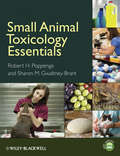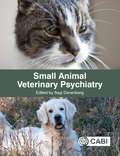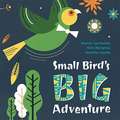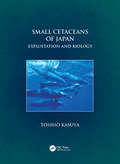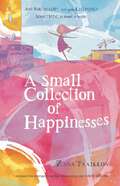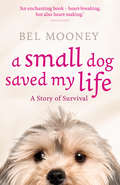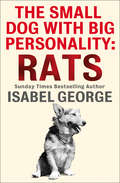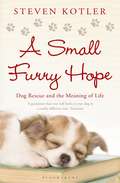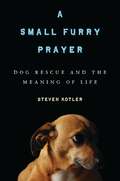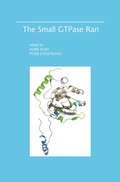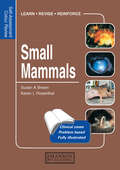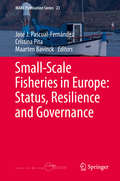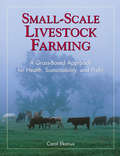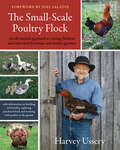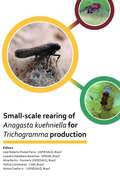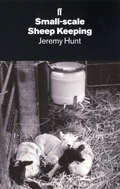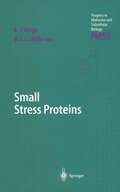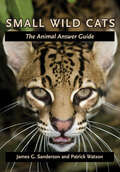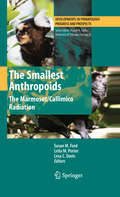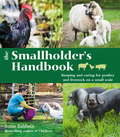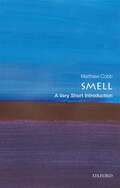- Table View
- List View
Small Animal Toxicology Essentials
by Robert H. Poppenga Sharon M. Gwaltney-BrantProviding a ready reference for the initial triage, collection of diagnostic samples, and management of a poisoning case, Small Animal Toxicology Essentials focuses on the most common poisons encountered by companion animals. From prevention to evaluation, monitoring, and treatment, the book is a guide for veterinary technicians to differentiate between significant and insignificant exposures and effectively manage animal poisonings. Emphasizing clinical signs, differential diagnoses, and case management, the book begins with the principles of veterinary toxicology, such as terminology, history-taking, and decontamination. The second half of the book is devoted to specific toxicants, including plants, metals, drugs, and household poisons. A companion website at www.wiley.com/go/poppenga provides review questions in Word and color images available for download into PowerPoint. Small Animal Toxicology Essentials is a useful resource for veterinary technicians, especially those with a interest in emergency and critical care, and veterinary technician students, as well as practicing veterinarians looking for an introduction to toxicology.
Small Animal Veterinary Psychiatry
by Ali Thompson Alison Blaxter Alex Darvill Ed Hall Tom Harcourt-Brown Lynn Hewison Angie Hibbert Katherine A. Houpt Jacqui Ley Samantha Lindley Sarah L. Liversage Professor Daniel Mills Carlo Siracusa Stephen Waisglass Helen ZulchProblem behaviours are often the result of how an animal thinks and feels, genetics, and environmental influences. Steering away from just description diagnoses and focusing instead on emotional and cognitive causes, this book provides a practical approach to diagnosing, treating, and managing behaviour pathologies in dogs and cats. Beginning by addressing cases in the first opinion practice, this book then considers physical disorders that may lead to or exacerbate abnormal behavior. From there, the focus shifts to mental and emotional health, from an assessment of normal behavior and giving juveniles an optimal start in life, to diagnosing mental and emotional disorders, addressing emotions such as anxiety and frustration, and how to manage these issues - by modifying behavior, managing the animal's environment, training, and, when necessary, the use of medications. The second half of the book then addresses owner concerns, including management problems, aggression, affective disorder, elimination disorder, abnormal and repetitive behaviours and ageing-related problems. With an emphasis on helping first line veterinarians identify common presentations and offer help to owners, this book: - Addresses both normal and abnormal behaviour in cats and dogs from an emotion and cognition perspective; - Provides behaviour modification protocols, and drug doses and indications; - Includes handouts to be used both within the practice and with clients to help the veterinary surgeon manage the case. Written by international experts, the book translates their insights and experience into approaches taken in behavioural medicine. Also including the most up-to-date drugs, it is an important resource for both small animal veterinarians and students of veterinary medicine or animal behaviour.
Small Bird's Big Adventure
by Nick MulgrewSmall Bird loves the Giant. But where is the Giant? Small Bird goes on an adventure to find her. Wesley van Eeden (illustrator), Jennifer Jacobs (designer), Bongani Kona (editor).
Small Cetaceans of Japan: Exploitation and Biology
by Toshio KasuyaThis book summarizes and analyzes the biology, ecology, exploitation and management of small cetaceans in Japan. It describes the various types of cetacean fisheries in Japan and their historical development, the life histories and ecologies of the main species involved, and the history and problems of conservation and management. The data show that in some cases the number of small cetaceans harvested exceed sustainable limits and have led to depletion of populations. The book provides a case study of what can go wrong when the needs of industry and conservation collide. The descriptions of life history and ecology are relevant to issues of conservation and management, not just for cetaceans, but for all fisheries around the world.
Small Cetaceans of Japan: Exploitation and Biology
by Toshio KasuyaThis book summarizes and analyzes the biology, ecology, exploitation and management of small cetaceans in Japan. It describes the various types of cetacean fisheries in Japan and their historical development, the life histories and ecologies of the main species involved, and the history and problems of conservation and management. The data show that in some cases the number of small cetaceans harvested exceed sustainable limits and have led to depletion of populations. The book provides a case study of what can go wrong when the needs of industry and conservation collide. The descriptions of life history and ecology are relevant to issues of conservation and management, not just for cetaceans, but for all fisheries around the world.
A Small Collection of Happinesses: A tale of loneliness, grumpiness and one extraordinary friendship
by Zana Fraillon'I enjoyed this strange, inventive and moving tale' DAVID ALMONDAn unforgettable story of friendship, hope and happiness from renowned Australian writer Zana Fraillon.Are you ready? Are you listening? Something is about to begin.When Ada arrives on the day of the Great Summer Storm, it is like the wind had picked her up and blown her in - walking stick and all - and dumped her right at the front gates of number 9 Hawkhurst Lane.Unfortunately, Ada is not the kind of neighbour Hettie was hoping for. Cranky, impatient and a hater of cats, Ada has no intention of making friends.But as the summer unfolds, Hettie and Ada discover they have more in common than they think. Could their unlikely friendship be the missing piece they never knew they needed?With illustrations by Stephen Michael King.'A gem of a book. The story is a powerful one of community and understanding, exploring deep themes with the lightest of touch - and warm humour. One of the best books I've read this year - I loved it' GILL LEWIS, author of Moonflight'A beautiful story of friendship and love across generations for readers aged 12+ who enjoy Karen Foxlee and Kate DiCamillo's books' BOOKS+PUBLISHING
The Small Dog With A Big Personality: Rats
by Isabel GeorgeAn inspiring and heart-warming short story of canine devotion and bravery.
A Small Furry Hope: Dog Rescue and the Meaning of Life
by Steven KotlerSteven Kotler was forty years old, single, and facing an existential crisis when he met Lila, a woman devoted to animal rescue. "Love me, love my dogs," was her rule, and Steven took it to heart. Spurred to move by a housing crisis in Los Angeles, Steven, Lila - and their eight dogs, then ten, then twenty, and then they lost count - bought a postage-stamp-sized farm in Chimayo, New Mexico. A Small Furry Hope chronicles their adventures at Rancho de Chihuahua, the sanctuary they created for their pack with special needs: the very old, the very sick, and, as Kotler says, "the really retarded." An insider look at the culture of dog rescue, A Small Furry Prayerweaves personal experience, and scientific inquiry into a fast-paced,fun-filled narrative that explores what it means to devote one's lifeto the furry and the four-legged. Along the way, Kotler combs throughevery aspect of canine-human relations, from long human history withdogs to brand new research into the neuroscience of caninecompanionship, in the end discovering why living in a world made of dogmay be the best way to uncover the truth about what it really means tobe human.
A Small Furry Prayer: Dog Rescue and the Meaning of Life
by Steven KotlerSteven Kotler was forty years old, single, and facing an existential crisis when he met Lila, a woman devoted to animal rescue. "Love me, love my dogs" was her rule, and Steven took it to heart. Spurred to move by a housing crisis in Los Angeles, Steven, Lila, and their eight dogs-then ten, then twenty, and then they lost count-bought a postage-stamp-size farm in Chimayo, New Mexico. A Small Furry Prayer chronicles their adventures at Rancho de Chihuahua, the sanctuary they created for their special needs pack. While dog rescue is one of the largest underground movements in America, it is also one of the least understood. An insider look at the "cult and culture" of dog rescue, A Small Furry Prayer weaves personal experience, cultural investigation, and scientific inquiry into a fast-paced, fun-filled narrative that explores what it means to devote one's life to the furry and the four-legged. Along the way, Kotler combs through every aspect of canine-human relations, from humans' long history with dogs through brand-new research into the neuroscience of canine companionship, in the end discovering why living in a world made of dog may be the best way to uncover the truth about what it really means to be human.
Small Mammals: Self-Assessment Color Review
by Susan A. Brown Karen L. RosenthalVeterinary practitioners are faced regularly by diseases and disorders in a large and ever increasing range of small mammalian patients. The Editors have gathered together contributions from 29 experts, who cover all aspects of medicine and surgery in small mammals including rabbits, guinea pigs, rodents, hedgehogs, ferrets, primates, squirrels, fo
Small-Scale Fisheries in Europe: Status, Resilience and Governance (MARE Publication Series #23)
by José J. Pascual-Fernández Cristina Pita Maarten BavinckThis book offers a comprehensive account of the status and dynamics of people participating in the small-scale fisheries (SSF) of Europe. It covers the situation of SSF in 25 coastal countries, thereby providing a portrait of almost every coastal country on the continent and analyzing the recent evolution of the sector. Small-scale fisheries are argued to be extremely important in Europe, as they provide employment and welfare, while increasing food sovereignty and maintaining communities in coastal areas. The recent worldwide focus on SSF derives from their environmental sustainability, which distinguishes many of their activities from those of large-scale fisheries. This book analyses the diversity of SSF and shows how fishing communities have sometimes developed successful governing models, demonstrating social and economic resilience. While the book emphasizes the strengths of SSF and the synergies that occur with other marine sectors, it also presents cases of failure, in which collective action and policy have actually contributed to a weakening of the sector. In this context, the book shows how governmental policies toward SSF vary considerably from country to country, in a way that is not entirely consistent with European policies.
Small-Scale Livestock Farming: A Grass-Based Approach for Health, Sustainability, and Profit
by Carol EkariusFull of practical everyday advice, this guide explains how a natural, organic approach to livestock farming produces healthy animals, reduces costs, and increases your operation&’s self-sufficiency. Livestock expert Carol Ekarius helps you create a viable farm plan, choose suitable livestock, care for your animals&’ health, and confidently manage housing, fencing, and feeding. Case studies of successful farmers provide inspiration as you learn everything you need to know to run a prosperous livestock farm and make the lifestyle of your dreams a reality. This publication conforms to the EPUB Accessibility specification at WCAG 2.0 Level AA.
The Small-Scale Poultry Flock: An All-Natural Approach to Raising Chickens and Other Fowl for Home and Market Growers
by Harvey Ussery Joel SalatinThe most comprehensive guide to date on raising all-natural poultry for the small-scale farmer, homesteader, and professional grower. The Small-Scale Poultry Flock offers a practical and integrative model for working with chickens and other domestic fowl, based entirely on natural systems. Readers will find information on growing (and sourcing) feed on a small scale, brooding (and breeding) at home, and using poultry as insect and weed managers in the garden and orchard. Ussery's model presents an entirely sustainable system that can be adapted and utilized in a variety of scales, and will prove invaluable for beginner homesteaders, growers looking to incorporate poultry into their farm, or poultry farmers seeking to close their loop. Ussery offers extensive information on: The definition of an integrated poultry flock (imitation of natural systems, integrating patterns, and closing the circle) Everything you need to know about your basic chicken (including distinctive points about anatomy and behavior that are critical to management) Extended information on poultry health and holistic health care, with a focus on prevention Planning your flock (flock size, choosing breeds, fowl useful for egg vs. meat production, sourcing stock) How to breed and brood the flock (including breeding for genetic conservation), including the most complete guide to working with broody hens available anywhere Making and mixing your own feed (with tips on equipment, storage, basic ingredients, technique, grinding and mixing) Providing more of the flock's feed from sources grown or self-foraged on the homestead or farm, including production of live protein feeds using earthworms and soldier grubs Using poultry to increase soil fertility, control crop damaging insects, and to make compost-including systems for pasturing and for tillage of cover crops and weeds Recipes for great egg and poultry dishes (including Ussery's famous chicken stock!) And one of the best step-by-step poultry butchering guides available, complete with extensive illustrative photos. No other book on raising poultry takes an entirely whole-systems approach, or discusses producing homegrown feed and breeding in such detail. This is a truly invaluable guide that will lead farmers and homesteaders into a new world of self-reliance and enjoyment.
Small-scale Rearing of Anagasta kuehniella for Trichogramma Production
by José Roberto Postali Parra Leandro Delalibera Geremias Aline Bertin Yelitza Colmenarez Aloisio Coelho Jr Jennifer Brown Janet R. ReidThis technical guide describes the techniques for small-scale rearing of the egg parasitoids Trichogramma spp. in the factitious host Anagasta kuehniella. These parasitoids are among the most widely used natural enemies in the world, and in Brazil are used to control lepidopteran pests in a wide variety of crops, including sugarcane, corn, soybean, cotton, vegetables (tomatoes, potatoes), fruit (avocado, citrus, grapes), and tobacco.
Small-Scale Sheep Keeping
by Jeremy HuntSmall-scale sheep keeping is one of the major growth areas of livestock breeding. The success of rare breeds and their proven commercial qualities has encouraged intense interest in minority sheep but whether you keep ten or a hundred ewes the same strict principles of management must be followed if success is to be achieved. This book aims to inform, encourage, advise and even entertain its readers. Sheep keeping can be a most enjoyable hobby but small flock owners all too often find it difficult to related to books aimed at the commercial producer. Sound, practical advice which is easily understood and efficiently put into practice is what this book offers.
Small Stress Proteins (Progress in Molecular and Subcellular Biology #28)
by A. P Arrigo W. E. G. MüllerSmall Wild Cats: The Animal Answer Guide (The Animal Answer Guides: Q&A for the Curious Naturalist)
by Patrick Watson James G. SandersonDid you know that most wild cat species are small and that lions, tigers, and other large cats are the exception? That adult bobcats, clouded leopards, and other small wild cats are completely asocial? And that they fight only as a last resort? This entertaining and informative book reveals these and hundreds of other facts about the behavior, biology, and conservation of the more than 30 small wild cat species. From bobcats to servals, small cats are spread across the globe. They range in size from the rusty-spotted cat and African black-footed cat, each of which weighs around 5 pounds when fully grown, to the Eurasian lynx, which can reach an adult weight of 60 pounds. These felids are elusive, some are nocturnal, others are arboreal, and all are rare and secretive, making them especially difficult to study. James G. Sanderson, the world’s leading field expert on small wild cats, and naturalist and wildlife artist Patrick Watson provide informative and entertaining answers to common and unexpected questions about these animals. The authors explain why some small cats live on the ground while others inhabit trees, discuss the form and function of their coat types and colors, offer scientifically sound information on human–small wild cat interactions, and even review the role that small wild cats have played in literature, religion, and mythology. The world of cats is as fascinating as it is diverse. Small Wild Cats: The Animal Answer Guide shows just how important and interesting the littlest of the nondomesticated feline family are.
The Smallest Anthropoids: The Marmoset/Callimico Radiation (Developments in Primatology: Progress and Prospects)
by Susan M. Ford Leila M. Porter Lesa C. DavisHere is a comprehensive examination of the newly recognized callimico/marmoset clade, which includes the smallest anthropoid primates on earth. It features sections on phylogeny, taxonomy and functional anatomy, behavioral ecology, and reproductive physiology.
The Smallholder's Handbook: Keeping And Caring For Poultry And Livestock On A Small Scale
by Suzie BaldwinThe Smallholder's Handbook is a detailed manual to start, plan and manage your own smallholding. Suzie explains the level of work involved, how much space you need and how to prepare your land. There are chapters on keeping poultry (chickens, turkeys, ducks and geese), as well as pigs, goats and sheep, cows and bees. She also explains why having a variety of animals makes the best use of your resources and how many of each type to keep. Comprehensive advice includes choosing breeds, transporting, feeding, housing, daily care and wellbeing, as well as international legislation that applies to livestock.
Smart Livestock Nutrition (Smart Animal Production #1)
by Ilias KyriazakisThis book highlights the latest findings and techniques related to nutrition and feed efficiency in animal agriculture. It addresses the key challenges facing the nutrition industry to achieve high animal productivity with minimal environmental impact. The concept of smart nutrition involves the use of smart technologies in the feeding and management of livestock.The first chapters focus on advances in biological fields such as molecular agriculture and genotype selection, as well as technologies that enhance or enable the collection of relevant information. The next section highlights applications of smart nutrition in a variety of livestock systems, ranging from intensive indoor housing of broilers and pigs to extensive outdoor housing of cattle and sheep, and marine fish farms. Finally, because of the worldwide attention to this issue, the authors address the environmental consequences.This work, which takes a serious look at how nutrition can be used to improve sustainability in animal agriculture, is a key literature for readers in animal and veterinary sciences, the food industry, sustainability research, and agricultural engineering.
The Smartest Animals on the Planet: Extraordinary tales of the natural world's cleverest creatures
by Sally BoysenWe have all heard talk of the intelligence of dolphins, elephants orgreat apes, or even, in different ways, ants and bees. But what is thisintelligence all about? How do we know which animals are smart, and howdo they use this superior intelligence?Written by one of the world's authorities in this field, this rivetingbook cover the themes of tool use, language, communication, imitationand social learning, numerical abilities, social cognition, emotion,self-recognition and awareness, drawing together the most recent andremarkable global research relating to almost every "smart" species. Fully illustrated, and including step-by-step illustrations to showexperiments and observations both in the field and in captivity,Covering the core themes of, this book delivers cutting-edge scientificresearch about a topic fascinating to anyone interested in the naturalworld.
Smell: A Very Short Introduction (Very Short Introductions)
by Matthew CobbOur sense of smell - or olfaction as it is technically known - is our most enigmatic sense. It can conjure up memories, taking us back to very specific places and emotions, whilst powerful smells can induce strong feelings of hunger or nausea. In the animal kingdom smell can be used to find food, a mate, or a home; to sense danger; and to send and receive complex messages with other members of a species. Yet despite its fundamental importance in our mental life and in the existence of all animals, our scientific understanding of how smell works is limited. In this Very Short Introduction, Matthew Cobb describes the latest scientific research on smell in humans and other mammals, in insects, and even in fish. He looks at how smell evolved, how animals use it to navigate and communicate, and disorders of smell in humans. Understanding smell, especially its neurobiology, has proved a big challenge, but olfactory science has revealed genetic factors that determine what we can and cannot smell, and why some people like a given smell while others find it unbearable. He ends by considering future treatments for smell disorders, and speculating on the role of smell in a world of robots. ABOUT THE SERIES: The Very Short Introductions series from Oxford University Press contains hundreds of titles in almost every subject area. These pocket-sized books are the perfect way to get ahead in a new subject quickly. Our expert authors combine facts, analysis, perspective, new ideas, and enthusiasm to make interesting and challenging topics highly readable.
Smell: A Very Short Introduction (Very Short Introductions)
by Matthew CobbOur sense of smell - or olfaction as it is technically known - is our most enigmatic sense. It can conjure up memories, taking us back to very specific places and emotions, whilst powerful smells can induce strong feelings of hunger or nausea. In the animal kingdom smell can be used to find food, a mate, or a home; to sense danger; and to send and receive complex messages with other members of a species. Yet despite its fundamental importance in our mental life and in the existence of all animals, our scientific understanding of how smell works is limited. In this Very Short Introduction, Matthew Cobb describes the latest scientific research on smell in humans and other mammals, in insects, and even in fish. He looks at how smell evolved, how animals use it to navigate and communicate, and disorders of smell in humans. Understanding smell, especially its neurobiology, has proved a big challenge, but olfactory science has revealed genetic factors that determine what we can and cannot smell, and why some people like a given smell while others find it unbearable. He ends by considering future treatments for smell disorders, and speculating on the role of smell in a world of robots. ABOUT THE SERIES: The Very Short Introductions series from Oxford University Press contains hundreds of titles in almost every subject area. These pocket-sized books are the perfect way to get ahead in a new subject quickly. Our expert authors combine facts, analysis, perspective, new ideas, and enthusiasm to make interesting and challenging topics highly readable.
